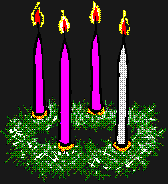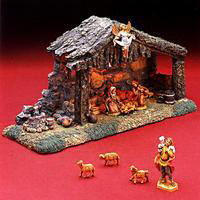Advent Customs X
5. Saint Nicholas | 6. The Crèche | 7. The "Octave" Before Christmas
|
|||
|
Many Catholics may be surprised to learn that the Advent wreath actually came from Lutherans living in east Germany. Yet though this custom is relatively recent as far as tradition goes, it has rightly earned a place of prominence among our Advent customs. A simple wreath made of evergreen (yew or fir or laurel) is adorned with four candles equidistant from each other. These candles may be of any color: in some European countries they are all white, though in the U.S. they generally correspond to the liturgical colors of the four Sundays of Advent (three | ||
purple and one pink or rose). In a dark room, a purple candle is lit on the First Sunday of Advent, another on the Second, the rose candle on the Third Sunday (in commemoration of Gaudete Sunday), and the last purple candle on the Fourth Sunday. Thus, all four candles will be lit for the week before Christmas. There is no formal ceremony for the lighting of the wreath or for the prayers that are said around it; there is not even an official Roman formula for blessing the wreath. Catholic families simply pray together for a holy preparation and a holy Christmas, concluding with a traditional Advent hymn. The symbolism of the Advent wreath is simple but effective. The wreath, with its crown-like character, reminds us of the King, while its circular shape betokens the "fulfillment of time" that both Comings bring about. The candles, on the other hand, represent the prophets whose inspired words pierced the darkness under which mankind groaned while waiting for the Messiah; they also represent the elects' hearts burning for Christ.
Another popular Advent custom, also from Germany, creates a similar build-up of anticipation. Advent calendars are colorful pieces of cardboard on which is depicted a many-windowed house. Behind the shutters of each house is a picture or symbol that points to the coming of Christmas. Beginning December 1, the children are allowed to open the shutters of one window per day. Finally, on December 24, the front door of the house is opened, showing the nativity.
St. Barbara, one of the Fourteen Holy Helpers, is the patron saint of artillerymen, miners, and a happy death. Though her feast on December 4 obviously belongs to the cycle of saints and not to the temporal cycle of Advent, there is a custom observed in her honor that ties into the meaning of the Advent season. A Barbara branch is the name given to a twig that is broken from a fruit tree (especially cherry), placed in a bowl of water, and kept in a warm, well-lit part of the house, such as the kitchen. According to legend, if the Barbara branch blooms on or before Christmas Day, good luck will come to the person whose branch it is. Aside from this harmless superstition, Barbara branches are reminiscent of the image from Isaiah of Christ as a Flower from the root of Jesse (Is. 11.2; the Epistle for Advent Ember Friday); they can thus be instructive in teaching children the meaning of Advent and Christmas. They are also used as the Saint's tribute to the Christ Child in the manger, lovingly placed in the crèche when they have blossomed.
The customs surrounding the Feast of St. Lucy (December 13) also illuminate the themes of Advent and Christmas. Lucy, whose name means light and whose association with light has made her the patron saint of the "light of the body" (the eyes), once had her feast fall on the shortest day of the year. (Before the Gregorian calendar was reformed in the Middle Ages, December 13 was the day of the winter solstice.) For all of these reasons, St. Lucy is honored with a number of customs involving fire. Lucy candles were once lit in the home and Lucy fires burned outside. In Sweden and Norway a girl dressed in white and wearing an evergreen wreath on her head with lit candles would awaken the family and offer them coffee and cakes. She was called the Lussibrud (Lucy bride) and her pastry the Lussekattor (see Foods section). Even today, safer versions of the St. Lucia crown (batteries instead of flames) can be purchased from Sweden from Catholic vendors like Dumb Ox Publications. The Feast of St. Lucy comes at a propitious time during the observance of Advent. Reminding us of the importance of light, the light of St. Lucy foreshadows the coming of the Light of the World on December 25 like a spark foreshadows the sun.
5. Saint Nicholas, Santa Claus, and the Angels As is well-known, "Santa Claus" comes from the Dutch rendering of Saint Nicholas, a fourth-century bishop famous for giving gifts anonymously to children and the needy. However, as Father Francis Weiser argues in his Handbook of Christian Customs (p. 113), the various legends surrounding Santa Claus actually come from the god of Norse and Germanic mythology, Thor (after whom Thursday is named). Thor was portrayed as a large, jovial old man with a long white beard whose symbolic color was red (owing to his association with fire). Thunder was said to have been caused by the rolling of his chariot (drawn by two white goats) across the clouds, and his home was said to have been "Northland," somewhere among the icebergs. The fireplace was also considered sacred to Thor because it was through it that he came into his element, the fire. We owe this odd metamorphosis of a Christian saint into a pagan god to New York City. When the Dutch founded the city in the seventeenth century, they observed the Catholic custom of "Saint Nicholas' visit" on the saint's feast day (December 5). This the Dutch did even though they were Protestant. When English Protestants later commandeered the city, they were offended by the practice, but their children very much liked it. The compromise that was eventually made was to transfer the giving of gifts from the 5th of December to the 25th and to add so many pagan elements to the story that the figure of the saintly Catholic bishop (who, incidentally, was notoriously intolerant of heretics) would no longer be recognizable. The older Christian custom is that on the night of December 5 (the vigil of Saint Nicholas Day), children write notes addressed to the Child Jesus and put them on their window sill, whence St. Nicholas carries them to heaven. A variation of this custom, prevalent in South America, is to write notes sometime between December 16 to 24 and to put them in front of the crib, from which point Angels carry the requests to heaven. Though the value of bringing children up on these stories is open to debate, at least the older customs explicitly tie the reception of gifts to the advent of Christ and portray the other figures (Nicholas or the angels) as His assistants. There was also a charming custom of "St. Nicholas" (a man dressed as a bishop) bringing gifts to children in person on his feast day. |
|||
|
|||
Another way of teaching children the meaning of Advent is by setting up the family's nativity scene, or crèche, with an empty manger. The infant Jesus can then be placed in the manger on Christmas morning (before the children awake?) or on Christmas Eve. In the meantime, one can adapt the popular French custom of preparing the manger. Each day of Advent children are allowed to place a wisp of straw in the manger for each good deed |
|
||
done that day. Thus the Christ Child, when He comes on Christmas Day, will find a soft bed of straw to protect Him from the hard boards of the manger. This simple custom teaches children that the acquisition of virtue is the best way to prepare for the Lord's coming. For the placement of the Magi in the crèche scene, see Christmas customs.
7. The "Octave" Before Christmas and/or the Golden Nights With each new Sunday heightening our sense of anticipation and with every Advent custom doing the same, it is little wonder that the eight days before Christmas became a semi-official octave of impatient expectation. This is expressed liturgically in the Divine Office's special magnificat antiphons for this period. Beginning on the evening of December 17 during Vespers, a "Greater" or "O" antiphon (so named for its opening vocative) is said which explicitly invokes the Son of God under various titles and begs Him to come (for the complete text in English, see Advent Schema). The Gregorian chant for these antiphons is exquisite, as are the antiphons themselves, which call attention to the Word's different manifestations to man in the Old Testament and to several of His divine attributes. The antiphons are also noteworthy for their "code." The titles for Christ from each antiphon form an acrostic which, when read backwards, spells, "ERO CRAS" -- "I will be [there] tomorrow!" It is as if Christ were answering our prayers through the prayers themselves. Finally, the Greater antiphons are the inspiration of the beautiful medieval hymn, Veni, Veni Emmanuel. Each stanza of this famous song is a poetic rendering of an antiphon, which is why the hymn is traditionally sung only during the eight days prior to Christmas. In many places, however, the octave of preparation was extended over nine days, making a Novena. By special permission, the "Golden Mass" of Ember Wednesday was sometimes offered in the pre-dawn hours for nine consecutive days prior to Christmas. Central Europe observed the "Golden Nights," a festive season honoring the Blessed Virgin, the expectant Mother of God; in fact, December 18 was once the Feast of the Expectancy in Spain. In the Alps, schoolchildren observed the custom of Josephstragen -- "carrying St. Joseph." Each night, a group of boys would carry a statue of St. Joseph to another boy's home. The night after the visit, the boy who had been visited would join the procession, making the number of carriers grow progressively larger. On Christmas Eve all the boys, accompanied by schoolgirls dressed in white, would process the statue through the town to the church, where it would be placed near the manger. In Latin America, on the other hand, a Novena to the Holy Child (La Novena del Niño) was held in which prayers would be said and lively carols sung in front of the church's empty manger. |
|||
|
|||
|
Much confusion surrounds what is arguably the season's most famous symbol. Christmas trees start appearing in shops, homes, and even some churches soon after Thanksgiving. Traditionally, however, the Christmas tree was not put up until Christmas Eve and was not taken down until the Vigil of the Epiphany. (Thus, it was only around for the Twelve Days of Christmas.) The reason for this will be explained in the section on Christmas customs; for now it suffices to | ||
| point out that the Christmas tree is not meant to be a part
of the Advent landscape. However, because finding a tree on December 24 can be difficult,
one practical measure is to buy the tree early and leave it in the home undecorated until
the 24th. An undecorated evergreen brought indoors is not a Christmas tree but a "Yule"
tree, a harmless, pre-Christian reminder of life to help dispel the gloom of winter.
When the tree is decorated, it will then be transformed from a natural token to a
Christian statement rich with supernatural symbols for the season. |
|||


